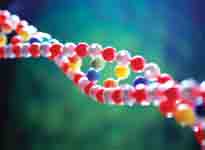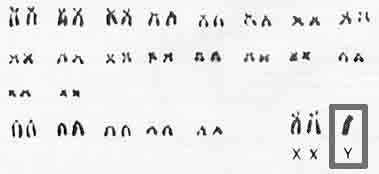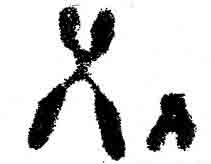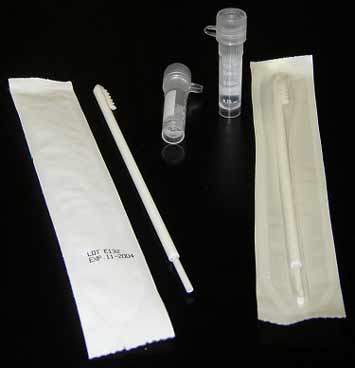GUTEKUNST GENEALOGY
Genetical
evidence to link the Gutekunst
Lines of
Oberschwandorf,
Haiterbach,
and Gündringen-Schietingen
|
Wouldn't it be fascinating to know that all Gutekunsts descent form one individual? ...and that the three non-related Gutekunst lines that appear in close-by villages in the Black Forest in the late 1500s are in reality one and the same family? There is a quite simple way to prove, if the assumption of a common origin is correct or not. I have used this method to connect different Gatter family lines (14 volunteers so far) (click here to see the Gatter DNA project and the project of my fellow Gatter-researcher Doug Mumma). |
 |
How does it work?
From elementary genetics we learn that the 23rd chromosome is the "sex" determining chromosome. Males have both an "X" and a "Y" 23rd chromosome. Females do not carry such a "Y", but have two "X" instead for their 23rd chromosome. The human egg becomes a female embryo if the male sperm carries an X-chromosome and a male embryo when the sperm has a Y-chromosome. Thus the Y-chromosome is passed down from generation to generation only through the male line. You might want to read an article about the Y-chromosome.
Several recent projects have reported on the use of the Y chromosome to trace and analyze surnames. Reuters issued a news release in early 2000 entitled, "Gene test helps scientist trace family names". In the article, Bryan Sykes of Oxford University was able to demonstrate, using DNA test results from a random sampling of 250 men with the Sykes surname, that they came from a common ancestor. Another fairly famous case involves the question as to whether or not President Thomas Jefferson fathered any slave children by Sally Hemings. The results clearly showed that one of her sons had a Jefferson Y chromosome, either from Thomas or one of his near relatives. A third study involves Jewish men who are kohanim, a Hebrew word literally meaning "priests". During the time of the First and Second Temples and up until the latter's destruction in 70 AD, the kohanim were responsible for performing elaborate rituals of animal sacrifices and grain offerings. Based on a study of 306 Jewish men in Israel, Canada and England, the researchers discovered that the 106 Jews who had identified themselves as kohanim shared genetic markers in their Y-chromosomes that members of the general Jewish population did not.
| Thus, it has been demonstrated that DNA tests of the male Y-chromosome can be used to trace the descendants of a particular man through many generations. See Alan Savin's short article Introduction to Genetic Genealogy as well as two excellent articles called "Genetics and Genealogy" by Kevin Duerinck and "The Y-Chromosome in the Study of Human Evolution, Migration and Prehistory" by Neil Bradman and Mark Thomas. |  |
|
|
The human Chromosomes. Number 21 determines the sex - XX for females, XY for males. |
 |
DNA testing will not help in genealogy if the family name was at one point passed on by a woman (e.g. if she had a child born out of wedlock). The child might have inherited this family's name, but not its "Y" chromoseme, but the one of its biological father. DNA testing will also not help if there was an unknown case of adoption down the line, or if one ancestor was the product of infidelity or rape. Again, he might have carried the family name, but he did not carry the family's "Y" chromosome. | |
|
..
X and Y chromosome |
.....
 |
The proof that DNA testing in privately funded family genealogy works and is not only a utopian dream, is the "Mumma Surname DNA Project" which has inspired this Gatter project. There are several laboratories carrying out such test. From the experience of the Mumma Surname DNA Project the Family Tree DNA, Inc. proved to be the most reliable and cheapest choice. |
|
|
... |
|
Extracting DNA is very easy. No blood is needed. Special cotton scrapers are used to rub the inside tissue of the mouth, more or less like a little tooth brush. This does not hurt. To the right you see a "DNA extraction kit" as we use it for our Gatter DNA research. The test kit consists of two cheek scrapers and two collection tubes---designed for a single persons use. Each tube contains a fluid designed to arrest bacteria growth, so you can scrape your cheek and return your kit in any type of weather (hot or cold). The freshness of your sample will remain intact for months. If you sign up to participate in the Gutekunst DNA project such a DNA extraction kit will be sent to you by mail along with a short manual on how to use it. |
 |
|
|
...
DNA Extraction Kit used for the Gutekunst Project |
|
Contact me at my email if you are interested in participating. Then I will sent you my Gatter DNA report as an example. If you want to sign up you can also directly go to the Gutekunst DNA Project on webpage of Family Tree DNA and order your test kit there: http://www.familytreedna.com/surname_join.asp?code=A61374&special=True For a start one participant for each of the three main lines (Oberschwandorf, Haiterbach, Gündringen/Schietingen) is sufficient. You would however need to be a male Gutekunst, and be able to trace your line back to one of these 3 German lines in a uniterupted male linage (son, father, grandfather, great grandfather, and so on, all need to have carried the Gutekunst name). If the name was once passed on by a woman (e.g. child born out of wedlock), it will not work. Of course also Gutekunst descendants with the name Goodart or Goodykoontz can take part. |
|
back
to the main Gutekunst page
Copyright:
Gutekunst Archive 2000-2008
Any distribution and use of material displayed on the Gutekunst Genealogy
Web Page
other than for personal purposes will be prosecuted.
Contact: <gatter.archive@googlemail.com>
